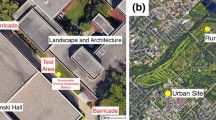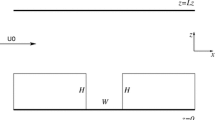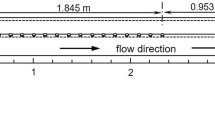Abstract
The Reynolds number for flow in a street canyon, Re = UrefH/ν (where Uref is a reference velocity, H the street canyon height, and ν the kinematic viscosity), cannot be matched between reduced-scale experiments and full-scale field measurements. This mismatch is often circumvented by satisfying the Re independence criterion, which states that above a critical Re (Rec), the flow field remains invariant with Re. Rec = 11,000 is often adopted in reduced-scale experiments. In deep street canyons with height-to-width aspect ratio ≥ 1.5, reduced-scale experiments have shown two recirculation vortices induced by the mean flows, but full-scale field measurements have observed only one vortex. We investigated this discrepancy by conducting water channel experiments with Re between 104 and 105 at three aspect ratios. The canyons with aspect ratio 1.0 have Rec = 11,000, the canyons with aspect ratio 1.5 have Rec between 31,000 and 58,000, while the canyons with aspect ratio 2.0 have Rec between 57,000 and 87,000. Therefore, the widely adopted Rec = 11,000 is not applicable for canyons with aspect ratio greater than 1.5. Our results also confirm that there is only one vortex in deep canyons at high Re. This single-vortex flow regime could change our fundamental understanding of deep canyons, which are often assumed to exhibit multiple-vortex flow regimes. Applications such as numerical model validation based on the multiple-vortex regime should be revisited. Our experimental data with Re up to 105 could be used to validate numerical models at high Re.






Similar content being viewed by others
References
Ahmad K, Khare M, Chaudhry K (2005) Wind tunnel simulation studies on dispersion at urban street canyons and intersections—a review. J Wind Eng Ind Aerodyn 93:697–717
Aliabadi AA (2018) Theory and applications of turbulence: a fundamental approach for scientists and engineers. Amir A. Aliabadi Publications, Guelph
Aliabadi AA, Krayenhoff ES, Nazarian N, Chew LW, Armstrong PR, Afshari A, Norford LK (2017) Effects of roof-edge roughness on air temperature and pollutant concentration in urban canyons. Bound Layer Meteorol 164:1–31
Baik J-J, Park R-S, Chun H-Y, Kim J-J (2000) A laboratory model of urban street-canyon flows. J Appl Meteorol 39:1592–1600
Britter R, Hanna S (2003) Flow and dispersion in urban areas. Annu Rev Fluid Mech 35:469–496
Brown MJ, Lawson RE, DeCroix DS, Lee RL (2000) Mean flow and turbulence measurements around a 2-D array of buildings in a wind tunnel. In: 11th Joint AMS/AWMA conference on the applications of air pollution meteorology. Long Beach, CA
Castro I, Robins A (1977) The flow around a surface-mounted cube in uniform and turbulent streams. J Fluid Mech 79:307–335
Caton F, Britter RE, Dalziel S (2003) Dispersion mechanisms in a street canyon. Atmos Environ 37:693–702
Chew LW (2017) Passive enhancement of air flow at pedestrian level in built environments. Master thesis, Massachusetts Institute of Technology
Chew LW, Nazarian N, Norford L (2017) Pedestrian-level urban wind flow enhancement with wind catchers. Atmosphere 8:159
DePaul F, Sheih C (1986) Measurements of wind velocities in a street canyon. Atmos Environ 1967 20:455–459
Eliasson I, Offerle B, Grimmond C, Lindqvist S (2006) Wind fields and turbulence statistics in an urban street canyon. Atmos Environ 40:1–16
Fernando H, Lee S, Anderson J, Princevac M, Pardyjak E, Grossman-Clarke S (2001) Urban fluid mechanics: air circulation and contaminant dispersion in cities. Environ Fluid Mech 1:107–164. https://doi.org/10.1023/A:1011504001479
Gerdes F, Olivari D (1999) Analysis of pollutant dispersion in an urban street canyon. J Wind Eng Ind Aerodyn 82:105–124
Huang Y, Hu X, Zeng N (2009) Impact of wedge-shaped roofs on airflow and pollutant dispersion inside urban street canyons. Build Environ 44:2335–2347
Kanda M (2006) Progress in the scale modeling of urban climate. Theor Appl Climatol 84:23–33
Kastner-Klein P, Fedorovich E, Rotach M (2001) A wind tunnel study of organised and turbulent air motions in urban street canyons. J Wind Eng Ind Aerodyn 89:849–861
Klein P, Clark JV (2007) Flow variability in a North American downtown street canyon. J Appl Meteorol Climatol 46:851–877
Koutsourakis N, Bartzis JG, Markatos NC (2012) Evaluation of Reynolds stress, k–ε and RNG k–ε turbulence models in street canyon flows using various experimental datasets. Environ Fluid Mech 12:379–403. https://doi.org/10.1007/s10652-012-9240-9
Kovar-Panskus A, Moulinneuf L, Savory E, Abdelqari A, Sini J-F, Rosant J-M, Robins A, Toy N (2002) A wind tunnel investigation of the influence of solar-induced wall-heating on the flow regime within a simulated urban street canyon. Water Air Soil Pollut Focus 2:555–571
Li X-X, Leung DY, Liu C-H, Lam K (2008) Physical modeling of flow field inside urban street canyons. J Appl Meteorol Climatol 47:2058–2067
Li X-X, Liu C-H, Leung DY, Lam K (2006) Recent progress in CFD modelling of wind field and pollutant transport in street canyons. Atmos Environ 40:5640–5658
Lim HC, Castro IP, Hoxey RP (2007) Bluff bodies in deep turbulent boundary layers: Reynolds-number issues. J Fluid Mech 571:97–118
Louka P, Belcher S, Harrison R (2000) Coupling between air flow in streets and the well-developed boundary layer aloft. Atmos Environ 34:2613–2621
Louka P, Vachon G, Sini J-F, Mestayer P, Rosant J-M (2002) Thermal effects on the airflow in a street canyon–Nantes’ 99 experimental results and model simulations. Water Air Soil Pollut Focus 2:351–364
Magnusson S, Dallman A, Entekhabi D, Britter R, Fernando HJ, Norford L (2014) On thermally forced flows in urban street canyons. Environ Fluid Mech 14:1427–1441. https://doi.org/10.1007/s10652-014-9353-4
Memon RA, Leung D (2011) On the heating environment in street canyon. Environ Fluid Mech 11:465–480
Meroney RN, Pavageau M, Rafailidis S, Schatzmann M (1996) Study of line source characteristics for 2-D physical modelling of pollutant dispersion in street canyons. J Wind Eng Ind Aerodyn 62:37–56
Nakamura Y, Oke TR (1988) Wind, temperature and stability conditions in an east-west oriented urban canyon. Atmos Environ 1967 22:2691–2700
Offerle B, Eliasson I, Grimmond C, Holmer B (2007) Surface heating in relation to air temperature, wind and turbulence in an urban street canyon. Bound Layer Meteorol 122:273–292
Oke T (1987) Boundary layer climates, 2nd edn. Methuen, London and New York
Santamouris M, Papanikolaou N, Koronakis I, Livada I, Asimakopoulos D (1999) Thermal and air flow characteristics in a deep pedestrian canyon under hot weather conditions. Atmos Environ 33:4503–4521
Snyder WH (1981) Guideline for fluid modeling of atmospheric diffusion. Environmental Protection Agency, Research Triangle Park
Uehara K, Wakamatsu S, Ooka R (2003) Studies on critical Reynolds number indices for wind-tunnel experiments on flow within urban areas. Bound Layer Meteorol 107:353–370
Vardoulakis S, Fisher BE, Pericleous K, Gonzalez-Flesca N (2003) Modelling air quality in street canyons: a review. Atmos Environ 37:155–182
Xie X, Huang Z, Wang J (2005) Impact of building configuration on air quality in street canyon. Atmos Environ 39:4519–4530
Yamartino RJ, Wiegand G (1986) Development and evaluation of simple models for the flow, turbulence and pollutant concentration fields within an urban street canyon. Atmos Environ 1967 20:2137–2156
Zajic D, Fernando H, Calhoun R, Princevac M, Brown M, Pardyjak E (2011) Flow and turbulence in an urban canyon. J Appl Meteorol Climatol 50:203–223
Zajic D, Fernando HJ, Brown MJ, Pardyjak ER (2015) On flows in simulated urban canopies. Environ Fluid Mech 15:275–303. https://doi.org/10.1007/s10652-013-9311-6
Acknowledgements
This research is supported by the National Research Foundation Singapore under its Campus for Research Excellence and Technological Enterprise programme. The authors thank Prof. Rajasekhar Balasubramanian and Dr. Kian Yew Lim for discussions on the experimental setup and result analyses. Help from the technical staff in the Hydraulic Engineering Laboratory is acknowledged.
Author information
Authors and Affiliations
Corresponding author
Rights and permissions
About this article
Cite this article
Chew, L.W., Aliabadi, A.A. & Norford, L.K. Flows across high aspect ratio street canyons: Reynolds number independence revisited. Environ Fluid Mech 18, 1275–1291 (2018). https://doi.org/10.1007/s10652-018-9601-0
Received:
Accepted:
Published:
Issue Date:
DOI: https://doi.org/10.1007/s10652-018-9601-0




